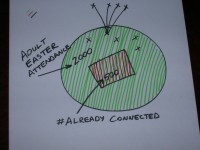Which Customer Is Your Ministry Designed to Connect?
When you read my question, you really want to say, "This is a business question or a marketing question." Or maybe you're thinking, "Our ministry is designed to connect everyone."
Believe me...I get that. I do. In fact, one of my proudest ministry moments is the development of our ministry statement: "We want to provide next steps for every Parkview adult and first steps for their friends." Sounds like we hope to connect everyone...doesn't it?
But we realized, and you need to realize, that it really doesn't work that way. We wish it would. But it doesn't. And it can't.
Just like restaurants decide who they want to attract and home builders decide who they want to sell to, you have to decide who your ministry is designed to connect.
Oh...there are definitely restaurants and home builders who try to please more than one customer. They just discover that it doesn't work that way. Usually right about the time they go out of business.
Just like restaurants decide who they want to attract and home builders decide who they want to sell to, you have to decide who your ministry is designed to connect. There are definitely restaurants and home builders who try to please… Share on X
Three Possible Customers
 I believe it is like this. If you think about your church in the sense of the diagram to the left, you can see that there really are three possible connection customers.
I believe it is like this. If you think about your church in the sense of the diagram to the left, you can see that there really are three possible connection customers.
NOTE: This is a very simplistic view. You should also understand that each of these three segments could easily be broken down into finer distinctions and that understanding would help you even further.
- There are the folks who are already connected (represented by the square in the middle).
- There are the folks in the circle (representing the people in your congregation and crowd who aren't already connected).
- And then, there's the group outside the circle (representing the community).
I want you to understand a critically important concept.
When you choose curriculum for a church-wide campaign or a small group connection you need to pay close attention to the topic, the length of the study, the title, really everything about it. And you really need to choose it to meet the needs of the people you are hoping to connect. Not the people who are already connected.
Let me tell you one last thing though. When you choose customers it won't make everyone happy. G.K. Chesterton's line notwithstanding, not everyone really believes that "the church is the only institution that exists solely for the benefit of non-members."
Let me tell you one last thing though. When you choose customers it won't make everyone happy. G.K. Chesterton's line notwithstanding, not everyone really believes that the church is the only institution that exists solely for the… Share on X
Further Reading:
Small Group Ministry Case Study: Choosing Your Customer
Does Your Topic Connect with Your True Customer?
Image by Esther Dyson



OK Mark just catching up. Great question! Can you give examples? I was thinking how would you target the circle or even the outside? It seems we in the church world (myself included) know how to intrinsically do the already connected. how do we design for the other groups?
The key to targeting certain customers is to acquire an accurate understanding of their needs, concerns and interests…and then offer a solution that makes sense to them. For example, if the primary kind of small group study you’re offering really requires prior knowledge of the Bible or is on a topic that only Christians care about…you’re unlikely to appeal to or attract folks from the crowd or community. On the other hand, if you offer a small group study on parenting that is based on easy to understand biblical principles…it will be much easier to attract from the crowd. I’ve mentioned this concept elsewhere when I’ve written about the Easy/Hard continuum (http://www.markhowelllive.com/the-easyhard-continuum/). Hope this helps!